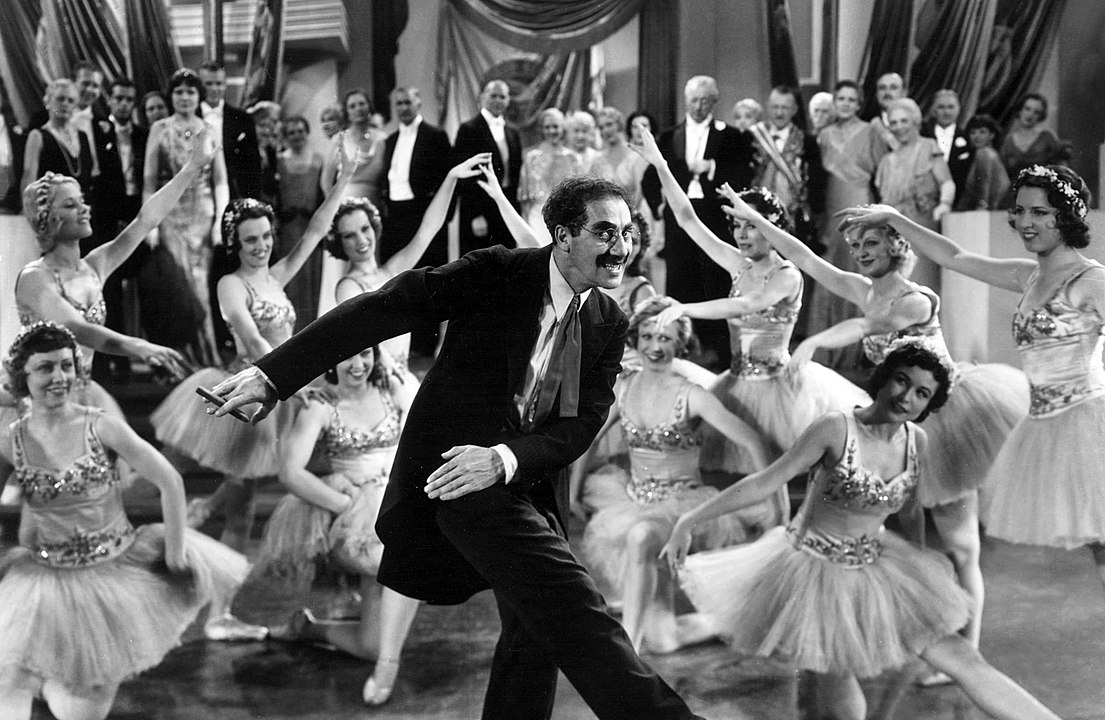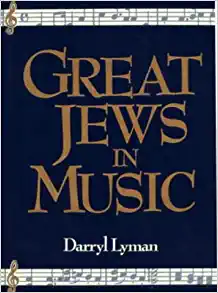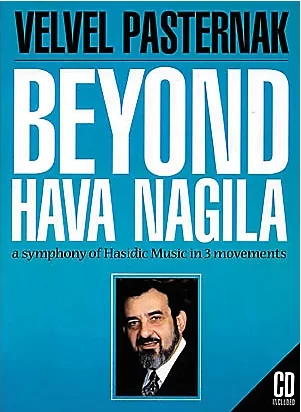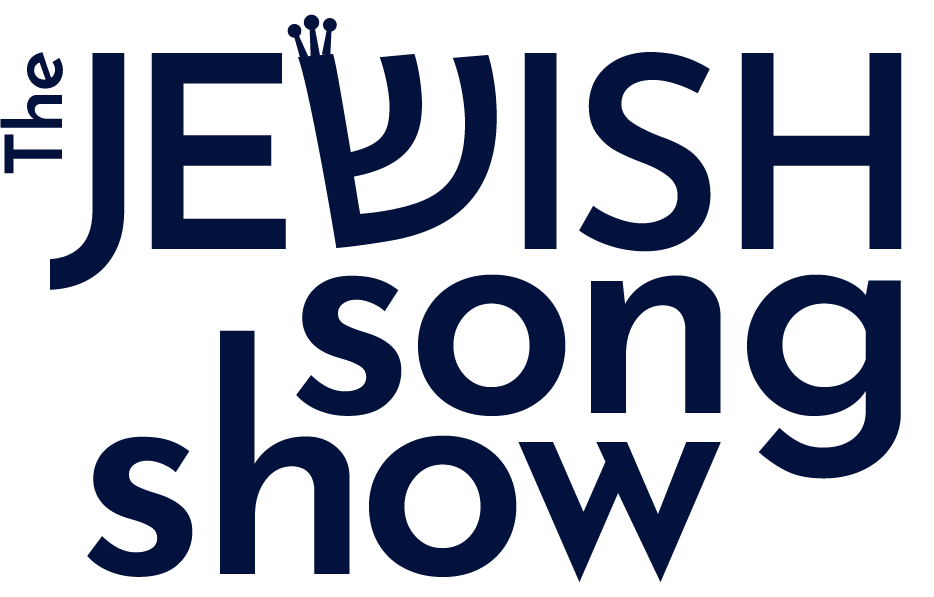“If you’ve read this story before, don’t stop me because I’d like to hear it again.” – Groucho Marx
Great jews in music?
Irving Berlin—né Yisrael Bellin—master of American song who gave us “There’s No Business Like Show Business”, “G-d Bless America”, and “Puttin’ On The Ritz” (clearly written with Young Frankenstein in mind) said of Groucho Marx, “The world would not be in such a snarl if Marx was Groucho instead of Karl.” What’s particularly clever and ironic about Berlin’s famous quip was that all three were Jews. Karl Marx gave us The Communist Manifesto. Groucho gave us Duck Soup. And, Irving Berlin gave us the most-beloved Christmas songs in the American Holiday Songbook.

A family friend gave me and my musical wife Darryl Lyman’s Great Jews in Music as a wedding present. Paging through the coffee-table tome, it struck me as odd that the book’s raison d’être was to feature musicians who happened to be Jews. I recognized most of the names. They were famous, for sure. But, Great Jews?

Did being famous musicians make them great? Or, because they were Jewish and famous? Honestly, I have to give props to the author; bringing Manilow, Mendelsohn, Mahler, and Mercer together in one volume is exceptional. Lyman provided a short and informative biography for everyone who made his list. But, I wanted more.
First, there was velvel
I can’t say whether it was Billy Joel’s all-vocal “The Longest Time” (with a bassist playing the low notes… that’s cheating), Bobby McFerrin’s seminal “Don’t Worry, Be Happy”, or—more likely—Spike Lee and Company’s Do It A Cappella PBS special that gave me the a cappella bug. But, man, I fell hard. In high school, college, after college—singing close harmony in small groups was my thing. After college, I put an ad in The Chicago Reader for auditions for a new a cappella vocal group. Working as a waiter at Skokie’s Slice of Life OBM, my friend (then manager), Janice Figman, introduced me to two of her friends who also liked to sing. One became the bass of the group, the other became my wife. (That’s a whole other story.) We started as a vocal-Jazz mixed quintet. After our first fateful gig at my Bubbe’s retirement home, half the group quit—the remaining members were Jewish. Rebecca Klein (not yet my wife) brought her wise pragmatism at this fateful moment to suggest, “Maybe we should focus on Jewish music now??”

I went to OSRUI as a kid. All I can really remember is sleeping in tents and sitting in circles on the kikar in thrall of Debbie Friedman (another story)—literally at her side. Our founding bass—Michael Mendelson—his grandfather was a Hazzan in Montreal. Rebecca was a Ramahnik and chorister of Roz Ebstein’s—zichrona livracha (z”l)—tenure at the Sager Solomon Schechter Day School in Skokie and Northbrook (Illinois). Roz’s mantra that, “every child has a voice and every child can sing,” was affectionately but sternly drilled into countless students whose lifetime familiarity with Jewish song is her indelible legacy.
Between the three of us, we had a repertoire of Jewish song experienced. When we came to record our first a cappella album, I created liner notes for the cassette tapes we ‘pressed’. I credited several of the songs as “Traditional,” assuming they were old folk songs passed down from generation to generation. To market and distribute our music beyond our parents, friends, and my synagogue’s Hanukkah Boutique, a musician friend suggested I reach out to Tara Publications, a music publisher in Owings Mills, Maryland who was creating the first website (this was 1993) to distribute Jewish titles. Tara had an expansive distribution network in Judaica stores across the country. My introduction to the founder and owner, Velvel Pasternak z”l, was a call I received from him. He was annoyed.
“Your credits are wrong in your liner notes,” he said. “The song Etz Chayim is not a traditional melody… it was written and published in 1975 by a person. His name is Tanchum Portnoy and he lives in Lawrence!” Portnoy’s setting of the text from Proverbs 3:18 is ubiquitously heard in synagogues around the world when the Torah scroll is returned to the Ark after the reading of the weekly portion, or parasha, on Shabbat morning. I apologized to Velvel. I confessed that I wished I knew more about the music our vocal group was singing. He said he agreed with me… and I should get his book. I did.

Beyond Hava Nagila is an autobiography—where Velvel shares wonderful stories about how he stumbled (his words) into the “Preserver of Hasidic Music” epitaph that the New York Times would bestow upon him when he passed in June 2019. It is also a musical travelogue where Velvel shares interesting stories and trivia for several dozen well-known Jewish songs and the people behind them. One story he shared really struck a chord with me.
In 1962, Benedict Stambler, of the Collectors Guild Recording Company, and I were invited to meet with the Bobover Rebbe in his Brooklyn residence. During our conversation, the Rebbe related that he had been perturbed when his young son brought home a melody that he had learned in his yeshiva. When the child was asked if he realized that the song had been composed by his paternal grandfather, the boy shook his head. Turning to us, the Rebbe said, “If my own child does not know the origins of our niggunim how can I expect my hasidim and their children to know?”
I’ll save an explanation of the Bobover Rebbe, his hasidim (students/followers), and their wordless songs—niggunim—for a future story, but I hope you get the gist. Velvel and the Bobover Rebbe both knew our Jewish music is a fleeting inheritance. Their shared dedication to transcribing melodies and disseminating them to others was, and continues to be, an effort to strengthen connection between the Jewish past and the Jewish future.
In the decades that followed, I called Velvel several times. Sometimes, just to hum a tune to him and ask him who wrote it… and if he knew a story behind it. I read more of his books and learned how he made a second (or third?) career out of traveling from shul to shul as a guest speaker to tell stories—and his story—about the Jewish music he loved. I was sad to hear that he was niftar in 2019 and reached out to one of his daughters to let her know how much he inspired me on my own journey of Jewish song.
The Deep Dive
For years, I feel like I’ve been trying to overcome that feeling of illiteracy from my first conversation with Velvel. This drive impelled me to troll resources from JStor to the Milken Archive to YouTube for information, recordings, images, interviews,… so much to fill that gap. I’ve learned so much as a result. But each year, the gap feels wider and wider. There is so much to know. Understanding more about hasidic music drew me to learn more about Jewish liturgical music. Gaining insights to popular Israeli music threw me into the colliding musical worlds of Ashkenazim (European), Sephardim (Iberian), Mizrahim (Middle East/Asia), and Beta Israel (Ethiopian) Jews. Modern songs spurred me to learn about the ancient songs that inspired them. There’s a name for this madness: ethnomusicology. Since there’s a website for everything else, I consulted the Society for Ethnomusicology for a diagnosis of my affliction.
Their website explains:
Ethnomusicology is the study of music in its social and cultural contexts. Ethnomusicologists examine music as a social process in order to understand not only what music is but what it means to its practitioners and audiences.
Ethnomusicology is highly interdisciplinary. Individuals working in the field may have training in music, cultural anthropology, folklore, performance studies, dance, area studies, cultural studies, gender studies, race or ethnic studies, or other fields in the humanities and social sciences. Yet all ethnomusicologists share a coherent foundation in the following approaches and methods:
1) Employing a global perspective on music (encompassing all geographic areas and types of music).
2) Understanding music as social practice (viewing music as a human activity that is interrelated with its social and cultural contexts).
3) Engaging in ethnographic fieldwork (observing and participating in music-making and related activities) and in historical research.
Oof. That’s quite a lot. This was turning my erstwhile fascination into a Full Time Hobby,… of which I have many. What I needed now was a focal point for my budding ethnomusicologic fetish.
A week ago in shul, I met the 8-year-old grandson of one of my fellow ‘door-duty’ (ie, synagogue lay security) acquaintances. As I kibitzed at the door with our synagogue security officer, the boy volunteered:
“I like velociraptors and other dinosaurs of the late Cretaceous period,” he said (dinosaur tee under his little-man blazer).
“Wow, that’s really specific. You know your stuff, dontcha?” I returned.
He responded plainly, “Yeah. I’m going to be a content creator when I get older.”
Inspired by my young friend, I went online to learn more about being a content creator. One helpful video suggested that content creators start by asking themselves the question: What problem are you trying to solve?
At different times in my life, singing or even being surrounded by Jewish song has been something that gives me a zetz in my kischkes. Is this something you feel, as well? Maybe it’s memory—the effective and immediate way that some songs take us back to a time that we cherished. Maybe it’s technical; those wailing, evocative tones that make some Jewish melodies sound so distinctive. Freygish (Yiddish) or Ahavah Rabbah (Hebrew) are the terms for that stirring Phrygian Dominant musical scale (#nerdalert).
Maybe it’s biological and/or social; we know that singing together changes the brain. Plus, it just feels awesome to sing with other people no matter how old you are.
Whatever its pull on us, I’m thinking that my own journey learning about and doing Jewish song is a big part of what has connected me to feeling Jewish and wanting to live a Jewish life.
Jewish Disconnection
Jews worry. I worry. And, there’s nothing like a national survey of 4,718 Jewish adults in the United States to give us something to worry about. The Pew Research Center’s “Jewish Americans in 2020” survey—here’s a summary—revealed some interesting findings about our community from the 68,398 interviews they conducted. Our numbers are stable at 2.4% of the US population, along with little change (since 2013) between the relative percent of Jews who are affiliated with Orthodox, Conservative, and Reform streams of practice. US Jews are older, more educated, and have higher levels of income. They are increasingly racially and ethnically diverse, particularly among younger respondents.
Remembering the Holocaust, living an ethical and moral life, working for justice and equality, and being intellectually curious are shared values that define Jewish identity for a majority of respondents. Three-quarters say they are concerned about anti-Semitism; more than half feel that they are less-safe as Jewish Americans than they did 5 years ago.
Twenty percent—half the national average of non-Jews—say that religion is, “very important in their lives.” Similarly, 12% go to synagogue “weekly or more often” (compared to 27% of the non-Jewish American public). Mirroring disaffiliation nationally, 50% attend services “seldom or never.” The 2020 survey addressed an unanswered question from the previous 2013 survey—namely why people go (or don’t go) to synagogue. Those who go shared that they find it spiritually meaningful (92%), feel a sense of belonging (87%), and go to feel connected with their ancestry or history (83%). Those who don’t cite, “not being religious” (67%), “not being interested” (57%), or choosing to express their Jewishness in other ways (55%).
As one might expect, engaging in Jewish cultural/ethnic activities (e.g. preparing/eating Jewish foods, reading Jewish literature, enjoying Jewish/Israeli music, consuming Jewish-themed TV and movies) is higher for those Jews who are more affiliated. Surprisingly—to me—the survey did not find a ‘bump’ for these activities among less/non-affiliated Jews as compensation for other more-formal practices (i.e. expressing their Jewishness in other ways).
The survey’s data about intermarriage was a surprise to no one. Intermarriage continues to rise—6 in 10 among couples married in the past decade. Beyond the acceleration in rate over past decades, the survey’s most interesting insight IMO is that multi-generational intermarriage is 82%—that is the percentage of intermarriage among children of intermarried parents—compared to 34% intermarriage for children of two Jewish parents. For intermarried Jews raising children under 18 years old, 28% are being raised in the Jewish religion, with the remainder as “partly-Jewish” or “Jewish in a non-religious way.”
Jews who define themselves religiously were twice as likely (67%) to feel an emotional attachment to Israel compared to those who consider themselves Jewish culturally or ethnically. Having lived in or visited Israel has an enormous effect on creating connection for Jews in the US (Thank you, Birthright!), but on the flipside, 60% of unaffiliated Jews feel little or no emotional connection with Israel as a Jewish homeland.
The 2020 survey included a new question aimed at helping to assess the importance to Jewish Americans of passing along their Jewish identity.
Asked to imagine a time in the future when they have grandchildren of their own (if they do not currently have any), roughly six-in-ten U.S. Jews say it would be very important (34%) or somewhat important (28%) for their grandchildren to be Jewish. Smaller proportions say it would be very (22%) or somewhat (22%) important for their grandchildren to marry someone who is also Jewish.
The answers to these questions tend to vary by age, with older Jews generally assigning greater importance to Jewish continuity and in-marriage than younger Jews do. But, as previously noted in this report, there is also a kind of divergence taking place in the U.S. Jewish population, with a rising percentage of young Jewish adults who are Orthodox as well as a rising share who describe themselves – in terms of religion – as atheist, agnostic or nothing in particular.
The question about future grandchildren captures one element of this divergence. Three-in-ten Jewish adults under the age of 30 (31%) say it would be “not at all” important for their future grandchildren to be Jewish, which is significantly higher than the share who say this in any other age group. At the same time, 32% of the youngest Jewish adults say it would be “very important” for their grandchildren to be Jewish, which is on par with the share who say the same among older age groups. Among the Orthodox, 91% say it is very important for their grandchildren to be Jewish, compared with 4% among “Jews of no religion.”

Questions about the Pew Report? Visit this page.
TACHLIS
In the demographic downpour of the Pew report, I got to thinking what can I do to help address these problems? For more than thirty years, the Jewish vocal group that I founded has been sharing an eclectic mix of Jewish culture and kitsch for communities from Vancouver to Naples to Munster to Munich. A great creative outlet. (I do love making noise on stage.) But, an hour-long a cappella show isn’t enough to scratch this Jewish ethnomusicology itch… nor “save the Jews.” It was time to get down to tachlis… Pronounced “tah-CHHHHK-lissss” (that’s a velar fricative in there; clear your throat and you’ve nailed it). That’s Yiddish for, “enough words, tateleh… let’s get to action.”
Could I combine the magic of Miss Frizzle and Georges Collinet and take Jewish (and not-yet-Jewish) listeners on a journey of Jewish discovery and connection… one song at a time? How would that work? Who would I collaborate with? What stories should we tell? Where to start? When to start? How would I get the resources I would need to do this? Oy! I needed a plan. What’s next??
P.S. I wrote this first blog post in September 2023. Then, October 7th happened.
